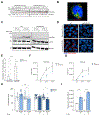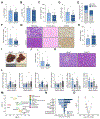HILPDA promotes NASH-driven HCC development by restraining intracellular fatty acid flux in hypoxia
- PMID: 37061197
- PMCID: PMC11238876
- DOI: 10.1016/j.jhep.2023.03.041
HILPDA promotes NASH-driven HCC development by restraining intracellular fatty acid flux in hypoxia
Abstract
Background & aims: The prevalence of non-alcoholic steatohepatitis (NASH)-driven hepatocellular carcinoma (HCC) is rising rapidly, yet its underlying mechanisms remain unclear. Herein, we aim to determine the role of hypoxia-inducible lipid droplet associated protein (HILPDA)/hypoxia-inducible gene 2 (HIG2), a selective inhibitor of intracellular lipolysis, in NASH-driven HCC.
Methods: The clinical significance of HILPDA was assessed in human NASH-driven HCC specimens by immunohistochemistry and transcriptomics analyses. The oncogenic effect of HILPDA was assessed in human HCC cells and in 3D epithelial spheroids upon exposure to free fatty acids and either normoxia or hypoxia. Lipidomics profiling of wild-type and HILPDA knockout HCC cells was assessed via shotgun and targeted approaches. Wild-type (Hilpdafl/fl) and hepatocyte-specific Hilpda knockout (HilpdaΔHep) mice were fed a Western diet and high sugar in drinking water while receiving carbon tetrachloride to induce NASH-driven HCC.
Results: In patients with NASH-driven HCC, upregulated HILPDA expression is strongly associated with poor survival. In oxygen-deprived and lipid-loaded culture conditions, HILPDA promotes viability of human hepatoma cells and growth of 3D epithelial spheroids. Lack of HILPDA triggered flux of polyunsaturated fatty acids to membrane phospholipids and of saturated fatty acids to ceramide synthesis, exacerbating lipid peroxidation and apoptosis in hypoxia. The apoptosis induced by HILPDA deficiency was reversed by pharmacological inhibition of ceramide synthesis. In our experimental mouse model of NASH-driven HCC, HilpdaΔHep exhibited reduced hepatic steatosis and tumorigenesis but increased oxidative stress in the liver. Single-cell analysis supports a dual role of hepatic HILPDA in protecting HCC cells and facilitating the establishment of a pro-tumorigenic immune microenvironment in NASH.
Conclusions: Hepatic HILPDA is a pivotal oncometabolic factor in the NASH liver microenvironment and represents a potential novel therapeutic target.
Impact and implications: Non-alcoholic steatohepatitis (NASH, chronic metabolic liver disease caused by buildup of fat, inflammation and damage in the liver) is emerging as the leading risk factor and the fastest growing cause of hepatocellular carcinoma (HCC), the most common form of liver cancer. While curative therapeutic options exist for HCC, it frequently presents at a late stage when such options are no longer effective and only systemic therapies are available. However, systemic therapies are still associated with poor efficacy and some side effects. In addition, no approved drugs are available for NASH. Therefore, understanding the underlying metabolic alterations occurring during NASH-driven HCC is key to identifying new cancer treatments that target the unique metabolic needs of cancer cells.
Keywords: HILPDA; Hepatocellular carcinoma; Hypoxia; Nonalcoholic steatohepatitis; lipid metabolism; lipidomics.
Copyright © 2023 European Association for the Study of the Liver. Published by Elsevier B.V. All rights reserved.
Conflict of interest statement
Conflict of interest
The authors declare no conflicts of interest that pertain to this work.
Please refer to the accompanying ICMJE disclosure forms for further details.
Figures







Comment in
-
HILPDA, a new player in NASH-driven HCC, links hypoxia signaling with ceramide synthesis.J Hepatol. 2023 Aug;79(2):269-272. doi: 10.1016/j.jhep.2023.05.009. Epub 2023 May 17. J Hepatol. 2023. PMID: 37207912 No abstract available.
References
-
- Younossi ZM, Blissett D, Blissett R, Henry L, Stepanova M, Younossi Y, et al. The economic and clinical burden of nonalcoholic fatty liver disease in the United States and Europe. Hepatology 2016;64:1577–1586. - PubMed
-
- Loomba R, Sanyal AJ. The global NAFLD epidemic. Nat Rev Gastroenterol Hepatol 2013;10:686–690. - PubMed
-
- Adams LA, Lymp JF, St Sauver J, Sanderson SO, Lindor KD, Feldstein A, et al. The natural history of nonalcoholic fatty liver disease: a population-based cohort study. Gastroenterology 2005;129:113–121. - PubMed
-
- Anstee QM, Reeves HL, Kotsiliti E, Govaere O, Heikenwalder M. From NASH to HCC: current concepts and future challenges. Nat Rev Gastroenterol Hepatol 2019;16:411–428. - PubMed
Publication types
MeSH terms
Substances
Grants and funding
LinkOut - more resources
Full Text Sources
Medical
Molecular Biology Databases

